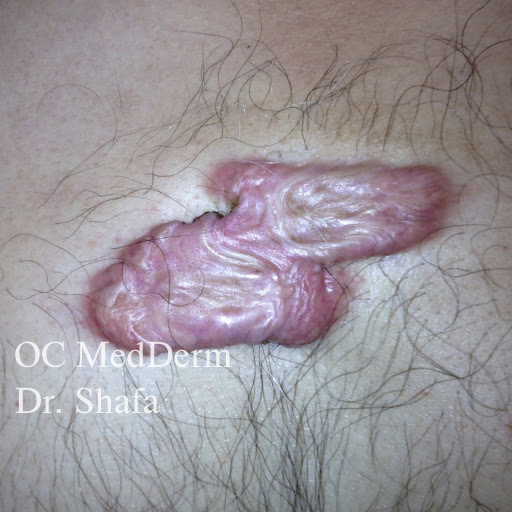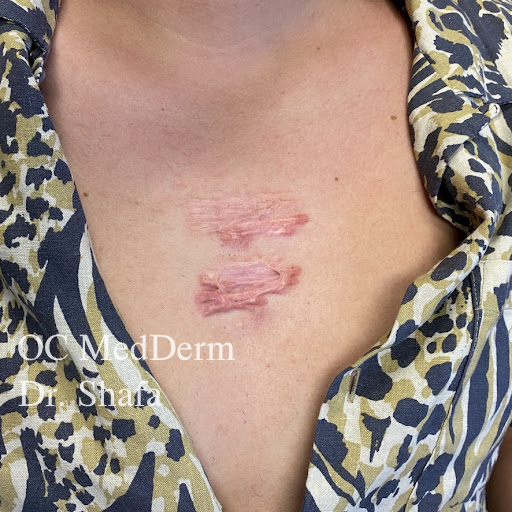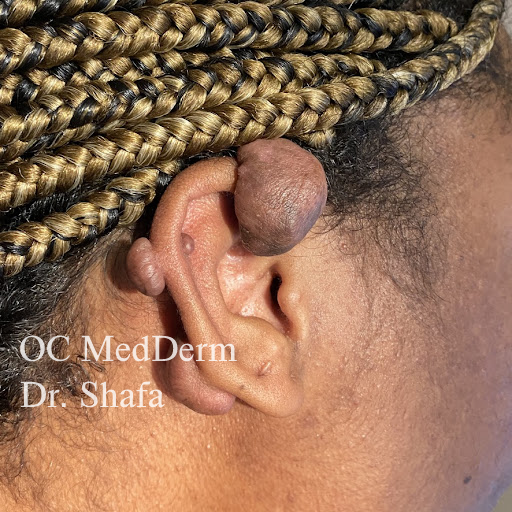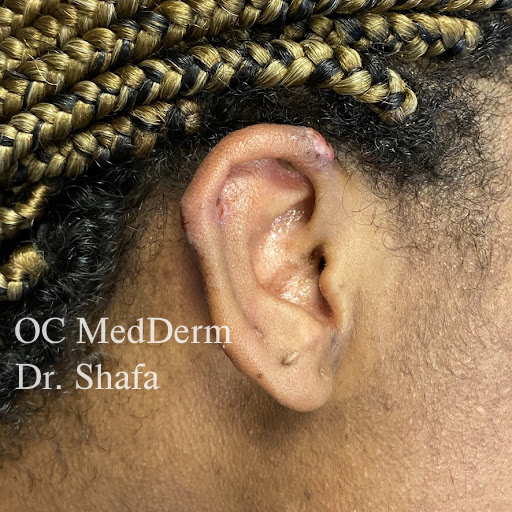Choosing Dr. Shafa means choosing a seasoned expert who is committed to providing top-quality, personalized care to achieve the best possible outcomes for your keloid treatment.

A keloid, often referred to as a “crab’s claw,” is an overgrown scar that can be painful, itchy, sensitive to touch, and aesthetically displeasing.
When the skin is injured, the body initiates a healing process by producing new cells and collagen to close the wound. Normally, this process stops once the wound is healed. However, in the case of a keloid, collagen production continues uncontrollably, leading to a thick, raised lump that extends beyond the original injury site.
Keloid formation is often a combination of genetic predisposition and environmental factors. Essentially, genetics “load the gun,” and trauma “pulls the trigger.” If you have the gene, any skin injury could trigger keloid formation.
Keloids can develop from a variety of skin injuries, including pimples, piercings, burns, trauma, surgical incisions, tattoos, and even acne.

Keloids are most commonly found on the ears, jawline, shoulders, and mid-chest.
Not necessarily. Raised scars can result from normal wound healing, known as hypertrophic scars. These scars typically shrink and flatten over time, a process called scar maturation. In contrast, keloids continue to grow beyond the original injury site and do not shrink on their own.
Hypertrophic scars usually develop within 6 to 12 weeks after an injury and tend to shrink over the following 6 to 12 months. Keloid formation, on the other hand, can begin at any time, even years after the initial injury, and they do not naturally regress.
Typically, keloids continue to enlarge and may eventually stop growing, but they do not shrink or resolve on their own without treatment.
If you have a personal or family history of keloids, you are at a higher risk of developing one after any skin injury. To reduce your risk:
Yes, some skin bumps and lumps can be mistaken for keloids. At OC MedDerm, Dr. Shafa will provide a precise diagnosis of your skin lump and recommend the most effective treatment options. If the diagnosis of a keloid is uncertain, a small skin biopsy may be performed to confirm it before starting a treatment plan.
The primary goals of keloid treatment are to alleviate uncomfortable symptoms such as pain, itching, and burning while improving the aesthetic appearance by flattening the keloid.
Keloids are more challenging to treat when they are multiple, larger, firmer, and have not responded to previous treatments.
No, effective keloid treatment typically requires a series of sessions, spaced one to three months apart, depending on the size and location of the keloid.
The first line and most commonly recommended treatment for keloids is a series of steroid injections directly into the keloid. This helps to halt growth and manage related symptoms.
Keloids are often sensitive to touch, both physically and psychologically. To minimize discomfort, steroids are mixed with numbing medication to ensure the keloid is numb during injection.
Intralesional injections carry risks such as skin thinning, increased vascularity, calcification, and indentation at the injection site. Keloid response to steroid injections can vary, so a series of treatments allows for adjustments in dosage and concentration based on your response.
Since keloids are triggered by skin trauma, further surgery at the keloid site is generally avoided unless the keloid has a narrow stalk, like a mushroom shape. This type of keloid, commonly found in the ears, can be surgically removed with subsequent injections to prevent recurrence.


Cryotherapy involves freezing the keloid with liquid nitrogen, and cooling it to -320 degrees Fahrenheit. It’s best used as an adjunctive therapy alongside injections and surgery to enhance results, particularly for flat keloids on the chest or jawline.
Some keloids are resistant to standard treatments and may require combination therapy. Laser therapy can be used in conjunction with injections and surgery to help control keloid regrowth. At OC MedDerm, Dr. Shafa will discuss the pros and cons of each treatment option and customize a plan that fits your keloid’s type, size, and location.
Pressure therapy and silicone gel can be used as adjunctive treatments to control keloid regrowth. However, these options may not be practical or comfortable for all keloid locations.
We’re here to help with any questions you may have or to assist in scheduling an appointment. At OC MedDerm, we are contracted with nearly all PPO health insurance plans to meet your medical needs. We also offer complimentary consultations for cosmetic procedures, including keloid treatments.
Whether you’re seeking expert advice or ready to start your treatment journey, we’re just a phone call away. Don’t hesitate to reach out—ask questions, get informed, and take the first step toward achieving your skin goals. Call us today!
Other Treatments
Broken Capillaries & Spider Vein Removal | Ear Surgeries, Cosmetic | Eye, Syringomas Removal | Eye, Xanthelasma Removal | Eyelid Bumps Surgeries, Cosmetic | Lumps and Bumps Removal, Cosmetic | Mole Removal, Cosmetic | Piercings, Face or Body | Scar Excision | Stretch Mark Correction
Book a consultation at OC Medderm | Irvineskin Today for Medical, Surgical, and Cosmetic Dermatology in Irvine & Orange County, CA.
We are experts in Acne, Pinch blepharoplasty, Ear lobe repair, Xanthelasma repair, Syringomas removal, mole removal, Keloid removal, Body and face piecing or piercing repair or removal, lump and bumps removal, Acne scar removal, Spider vein treatment, fungal infection, Co2 resurfacing, Warts and more.
You can schedule an appointment or call us now for all the dermatology treatments. We are located at 113 Waterworks Way 100, Irvine, Orange County CA, We Are Dedicated to Providing the Best & Transparent Dermatology Care for your skin.
Call us when you want!